|
G |
Garret Solyomis an author who wrote together with his wife Bronwen Solyom the book The World of the Javanese Keris. |

Gayamanis the name for a form of a warangka area of Surakarta and Yogyakarta. It is similar in the form of Tahiti chestnut (buah Gayam). Hence the name Gayaman comes. The warangka Gayaman Yogykarta and Gayaman Surakarta are very different. The Gayaman forms on Madura or Bali are again very different. This form of warangka very often is used because it is very simple, does not take up much space and can not break so fast. Secondly, these warangka is used in the fields to complete the clothing. Other warangka forms are Ladrang and Sandang Walikat. There are of the warangka Gayaman 7 subspecies: 1. Warangka Gayaman Gandon oder Lugas 2. Warangka Gayaman Kagok 3. Warangka Gayaman Gabel 4. Warangka Gayaman Ladrang 5. Warangka Gayaman Bancihan oder Bancean 6. Warangka Gayaman Pelokan 7. Warangka Gayaman Cempaluk Since the mid-20th century are mostly found Gayaman Gandon and Gabel, the other are rare. In Surakarta and Yogykarta the warangka Gayaman is almost never used by the staff of the Keratons or at events, because it is a part of everyday clothing. You can find pictures of the types and description of the parts of this warangka here. |
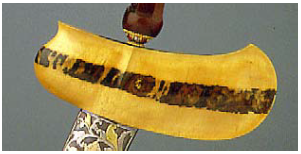
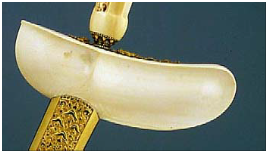
Gedu, Empu Kiis the name of two well-known Empu. |
Gendokor Gendokan or Wetengan also Waduk is a part in the center of the Ganja. This part looks like a well-fed belly. This part can be found in the vicinity of Leng-Lengan, the hole for the Pesi. |

Gendongis in the area of Surakarta a part of a handle made of wood Tayuman. It has a Unyeng and is located on the back of the handle. A Unyeng is something like a knothole. |

Genyodihardjolived from 1928 to 1989 and was a Empu in Yogyakarta. He was the older brother of Empu Djeno Harumbrodjo and the 4th child of Kyai Empu Supowinangun. Although he was older than Djeno are not as well known his work.
Two twin krisses from Empu Genyodihardjo |

Graham Gajah, Fosilis a material for a warangka or a handle. It is made of the molar tooth of an elephant. It is only for an Awar-Awar and not used for gandar because it is too hard and could damage the Keris.
Hilt and Warangka from Graham Gajah molar, Warangka in Tanggalan style |
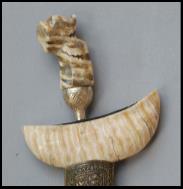
Gliwangis a traditional weapon from Aceh. The form is much more slender like a Kelewang. There are two types: Gliwang Tauhaj Gejong with a length of about 100 cm and the top is thicker than the lower end. In Gliwang Lipeuh Ujong the length is about 90 cm and the top is exactly as thin as the lower part. The back near the tip is sharp. |
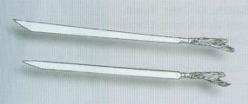
Godiis a yarn layer on the top of a handle of a Tombak. This serves to ensure that one can hold the handle better. There are 65 to 85 wraps, depending on the size of the thread used. The length of the wrapping is 22 to 27 cm. |

Godonganor Bapangan is a part of a Waranga Ladrang or Branggah in the rear. It looks like a sheet of, hence the name Godongan, in Javanese's blade Godong. A Godongan is one of the important Ricikan a warangka. This part cannot be repaired and the entire warangka must be replaced. |

Godong Andongor Ron Andong is the Dapur of a straight Tombak. The shape is similar to the Andong blade. In the middle of the blade there is an Ada-Ada, which runs from the lower part almost to the top. Other Ricikan are not there. This Dapur is found in ancient Tombak. It was not a weapon of war, but Pusaka. |

Godong Dadapor Ron Dadap is a Dapur of a straight Tombak. The shape is like the leaf of a coral tree, wide, symmetrical and thin. In the middle it has a thin Ada-Ada from the bottom almost to the top, there is no other Ricikan. Usually these are small Tombak. It is a Pusaka Tombak and no weapon of war. |

Godong Pringor Ron Pring is the Dapur of a straight Tombak. The shape resembles the leaf of bamboo and is symmetrical. The blade is thin and almost without Ada-Ada. It is so thin that one hardly sees. The blade has a kind of waist, other Ricikan are not there. Godong Pring is a popular Dapur and one often finds such Tombak. |

Godong Suruhor Ron Pring or Godong Sedah or Ron Sedah is the Dapur of a straight Tombak and is usually small. It is like the leaf of a betel nut plant (sirih) in the middle of wide, symmetrical and thin. In the blade center can be found from the bottom to the top of an Ada-Ada, other Ricikan are not found. |

Golokis a Pedang Sabet, which is normally heavy because the blade is thick. The blade is up relatively straight and down tortuous. Only the lower part is sharp. Because a Golok is usually heavy, it is not very long. Generally a Golok has no pamor and is made of a mixture of steel and iron, the iron content is higher than of other Pedang. |
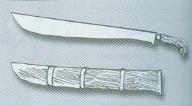
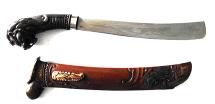
Grenengis a Ricikan or part of a circle and can be found on the back on the lower part of the blade and Ganja. There are various forms of Greneng. There are some keris experts who say that Greneng is the signature of Empu. The parts and forms of Greneng you can find here.
|
Groneman, Dr. Isaacis a 1832 in Zutphen, The Netherlands, born in 1912 and deceased in Jogjakarta physicians and Indonesia expert. He is known for his 1910 published book The Javanese Kris. It is very popular to read relatively complete and well. This book is written in the original in German, as this was the language of scholars at that time. The book in English can be found here, and most versions in German are included in this book. |

Gula MilirIn the world of keris there are two meanings. The first meaning is the form of a Kembang Kacang, the second a groove a slight depression behind the Gusen. Geula Milir is the extension of Kruwingan beginning at the Sorsoran to the half of the blade. Not all have a keris Gula Milir. The old Tangguh as Majapahit and previously have not Ricikan Gula Milir. |

Guling, Empuis a known Empu who lived in the time of the Kingdom of Mataram. His works are very valuable and are still wanted. |
Gulu Meledis a part of the Ganja behind the Sirah Cecak and before Wetengan or Gendok. It resembles the neck of a house lizard. There are three types: landing (long), Sedeng (normal) and Cekak (short). |

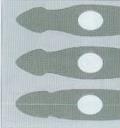
|
Gulu Meled Landung
Gulu Meled Sedeng
Gulu Meled Cekak
|





